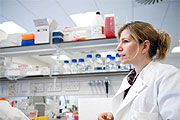Source: Strathclyde University Archives
Notable People
Sir Samuel Crowe Curran
-
Samuel Curran

-
Department of Natural Philosophy 1952

Source: University of Glasgow
-
Samuel Curran 1952

Source: University of Glasgow
-
Sam Curran's matriculation record page 1, 1931

Source: University of Glasgow
-
Sam Curran's matriculation record page 2, 1931

Source: University of Glasgow
-
Sam Curran

Source: Reproduced with kind permission of the family of Bruno Touschek
-
Bruno Touschek and Sam Curran

Source: Reproduced with kind permission from the Touschek Family
-
Philip Dee and Sam Curran on the occasion of Dee receiving his honorary degree at Strathclyde University, 1980

Source: University of Glasgow
Physicist and University Administrator
Born 23 May 1912.
Died 25 February 1998.
An exceptional physicist whose inventions were used in laboratories all over the world.
Connection to the University of Glasgow: Alumnus, Lecturer
GU Degrees: MA, 1933; BSc, 1934; PhD, 1937;
Discover more Physicist on the University of Glasgow Story website
Achievements
The following achievements are associated with Sir Samuel Crowe Curran:
Invention of the proportional counter
Sir Samuel Curran, a recognised world leader in his field, invented the two basic techniques for the detection of the passage of elementary particles, the scintillation counter, and the proportional counter for the detection of radiation sources.
Invention of the scintillation counter
Sir Samuel Curran, a recognised world leader in his field, invented the two basic techniques for the detection of the passage of elementary particles, the proportional counter, and the scintillation counter to measure a number of different radiations.
Honours
The following honours are associated with this person:
Biography
Sir Samuel Curran (1912-1998) was an exceptional physicist who was a graduate of the University and a Lecturer in Natural Philosophy in the Physics Department from 1945-1955. He was famous for inventing the scintillation and proportional counters, the two basic techniques for the detection of elementary particles, which were used in laboratories over the world.
Curran was born in Ballymena in Northern Ireland but he grew up in Wishaw, Scotland. He attended Wishaw High School before beginning his studies at the University of Glasgow. He graduated with a First Class MA Honours degree in Natural Philosophy in 1933 and a with a BSc the following year. He then joined the Physics Department as a research student and holder of the Metcalf Fellowship, and began researching beta rays. In 1937 he completed his thesis on "The Investigation of some wave properties of beta rays" and graduated with a PhD.
He then moved to St John's College, Cambridge to begin research into proton capture with the aim of completing another PhD. He worked at the Cavendish laboratory with Philip Dee as his supervisor. During the war he turned his inventiveness to radio and radar detection, and also worked in the United States on the Manhattan Project in 1944 (development of the atomic bomb). It was at this time that he invented the scintillation counter.
He was appointed as a lecturer in Natural Philosophy at Glasgow on his return in 1945 and began working again with Philip Dee who was Professor of Natural Philosophy in the Physics Department. It was here that he invented the proportional counter. In 1955 he left the University and joined the Atomic Weapons Research Establishment in Aldermaston and worked on developing a hydrogen bomb. He was elected a Fellow of the Royal Society of Edinburgh in 1947 and of the Royal Society of London in 1953.
In 1959 he was appointed Principal of the Royal College of Science and Technology in Glasgow and was instrumental in leading the institution to University status in 1962. He was knighted in 1970. He died on 25 February 1998.

